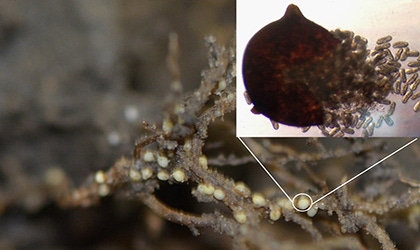September 26, 2018

Source: South Dakota State University
By Emmanuel Byamukama and Connie Tande.
A famous nematologist in the region once asked the question “Who should be concerned about the soybean cyst nematode” and the answer was “those who know they have SCN in their fields and those who don’t”. In other words, all of us should be concerned. SCN is the most important soybean production constraint, it is estimated to cause more than $1 billion in revenue losses annually across the U.S. Moreover, SCN eradication from soil is practically impossible, however, it can be managed to keep the numbers below levels that can cause heavy yield losses.
The first step towards managing the soybean cyst nematode (SCN) is to test your soil. This will help to determine whether a field is infested with SCN, if so management practices can then be implemented. It is important to periodically test your soil, whether the field is found to have SCN or not, to determine if current applied management practices are reducing the SCN numbers or if a change in management tactics is needed With soybean harvest starting, this is the best time of year to sample the soil for SCN. The SCN soil test is free of charge to South Dakota producers, courtesy of the South Dakota Soybean Research and Promotion Council.
To sample soil for SCN, use a soil probe or spade to obtain 15-20 soil cores 0-6 inches deep targeting symptomatic areas such as the field entrances, low spot areas, consistently low yielding areas, and along the fence line. Soil from within the soybean rows (root zone) should be targeted. Bigger fields should be divided into 15-20 acre parcels and each parcel sampled separately. Fall sampling of soybean fields is probably the most accurate time to test, but fields that are not currently in soybeans this year but will be planted into soybeans the next growing season can also be tested for SCN. Soil samples for SCN testing can be mailed or dropped off at:
SDSU Plat Diagnostic Clinic
Department of Plant Science
SPSB 153, Box 2108
Brookings SD 57007
Phone: 605.688.5545
SCN Management
Know your SCN numbers.Practice crop rotation in order to avoid SCN populations from building-up. For fields with a high SCN population (>10,000 eggs/100cc of soil), longer rotations away from soybeans are encouraged.
Plant SCN resistant cultivars. SCN resistant cultivars help curtail SCN build-up in soil.
Rotate within SCN resistant cultivars to avoid SCN populations from adapting to a single source of resistance. Although most SCN resistant cultivars have resistant genes derived from PI88788, rotating with different cultivars with this gene is still helpful. A few cultivars that have resistance derived from Peking (PI #1) are also becoming available.
Control weeds proactively. Some weeds such as field pennycress and purple deadnettle are good hosts for SCN, therefore controlling these weeds in fall can help prevent the continued reproduction of SCN in the field when the soybean is not present.
For fields with high SCN population, (>10,000 eggs), use of nematicide seed treatments may help reduce yield losses. Available nematicide products can be found in the 2018 South Dakota Pest Management Guide: Soybeans (seed treatment section)
Originally posted by South Dakota State University.
You May Also Like




